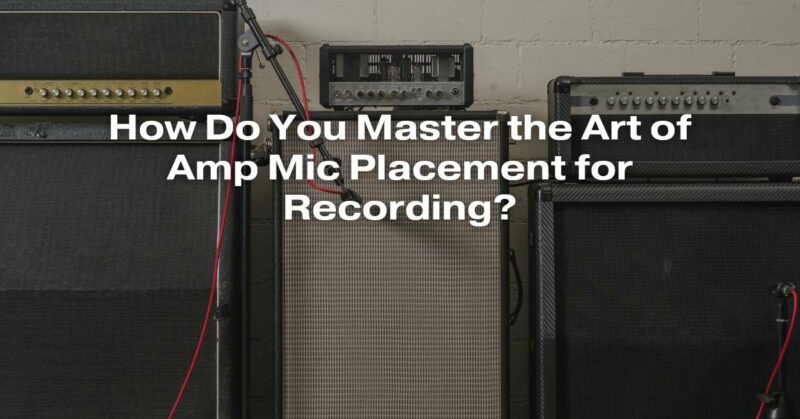Recording electric guitar amps can be a challenging task, but it’s also one of the most critical aspects of capturing that perfect tone for your music. The art of amp mic placement is an essential skill for any recording engineer or musician looking to achieve professional-quality guitar recordings. In this comprehensive guide, we’ll delve into the intricacies of amp mic placement and provide you with tips, techniques, and best practices to help you master this craft.
- Understanding the Basics
Before we dive into the specifics of mic placement, it’s essential to understand the basic components involved:
a. The Guitar Amp: The amplifier is the source of the guitar’s sound. Understanding its settings and tone is crucial.
b. Microphones: Different microphones capture sound differently. Dynamic and condenser microphones are commonly used for amp miking.
c. Room Acoustics: The acoustic properties of the recording room can significantly impact your recordings. Consider room treatment.
d. Mic Preamps: Good mic preamps are essential for capturing the nuances of your amp’s tone accurately.
e. Monitors: High-quality studio monitors will help you accurately assess your recordings.
- Choosing the Right Microphone
Selecting the appropriate microphone is the first step in achieving great amp recordings. Here are some considerations:
a. Dynamic vs. Condenser: Dynamic mics are robust and handle high sound pressure levels (SPL) well, making them ideal for close-miking loud guitar amps. Condenser mics are more sensitive and capture more detail, making them suitable for room or distant miking.
b. Microphone Models: Different microphones have unique characteristics. Experiment with different models to find the one that complements your amp’s tone.
c. Polar Patterns: Microphones have different pickup patterns (e.g., cardioid, omnidirectional). Cardioid patterns are often used for amp miking as they focus on the source and reject background noise.
- Mic Placement Techniques
The placement of your microphone(s) is crucial in capturing the desired tone. Here are some mic placement techniques to consider:
a. Close-Miking: Placing the microphone close to the amp’s speaker cone captures a focused and direct sound. Experiment with the mic’s angle and distance from the speaker to find the sweet spot.
b. Off-Axis Miking: Angling the microphone slightly off-axis from the speaker cone can help reduce harshness and capture a smoother tone.
c. Room Miking: For a more ambient and roomy sound, place a microphone further from the amp. Experiment with room acoustics and mic placement to achieve the desired ambiance.
d. Multiple Mics: Using two or more microphones on the same amp can provide depth and complexity to your tone. Common configurations include blending a close dynamic mic with a room condenser mic.
- Room Acoustics
The acoustic properties of your recording space can significantly influence your guitar amp recordings. Consider the following:
a. Room Treatment: Use acoustic treatment like bass traps, diffusers, and absorbers to control reflections and resonances in your recording space.
b. Mic Positioning: Experiment with microphone placement to find positions where room reflections enhance your tone rather than detract from it.
c. Isolation: If possible, isolate the guitar amp in a dedicated tracking room to minimize external noise interference.
- Monitoring and Adjusting
After setting up your mics and recording, it’s crucial to monitor your recordings and make adjustments as necessary:
a. Use high-quality studio monitors to accurately assess your recordings.
b. Pay attention to phase issues when using multiple microphones. Phase alignment tools can help.
c. Make subtle adjustments to mic placement or amplifier settings as needed to achieve your desired tone.
Conclusion
Mastering the art of amp mic placement for recording is a skill that takes time and practice to perfect. By understanding the basics, choosing the right microphones, experimenting with placement techniques, considering room acoustics, and monitoring and adjusting your recordings, you can capture the perfect guitar tone for your music. Remember that there are no one-size-fits-all rules; it’s all about finding what works best for your unique sound and style. With dedication and patience, you’ll be well on your way to producing professional-quality guitar recordings.


